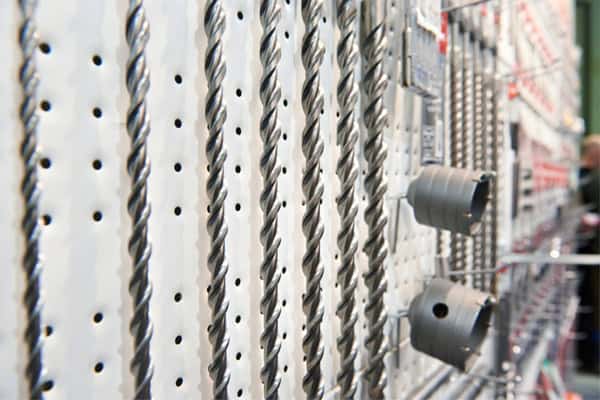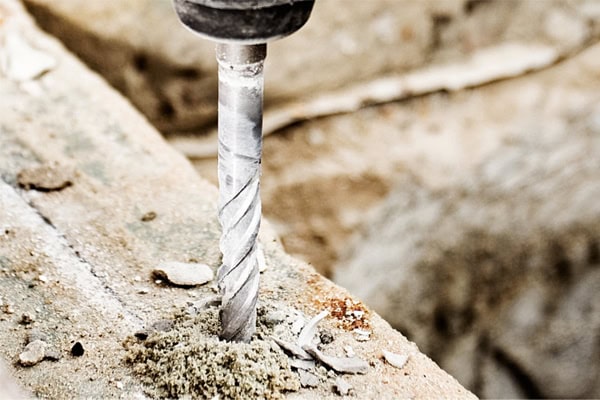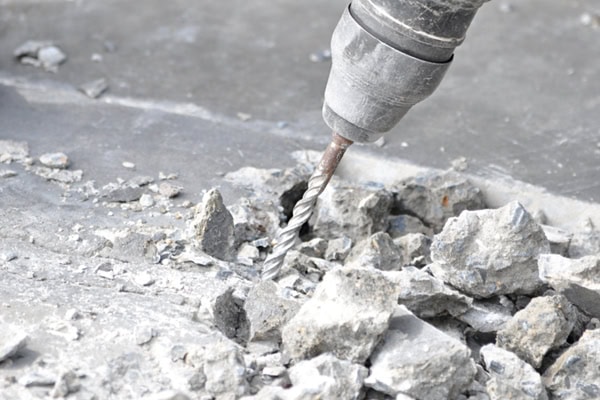Worried about making a mistake and ruining your concrete project1? Don’t sweat it! Drilling into concrete2 can seem tough, but with the right know-how, it’s totally manageable.
To drill into concrete successfully, you’ll need a hammer drill, a masonry bit, and some patience. Mark your spot, start slowly, and let the drill do the work. Remember safety gear!

Ready to learn the specifics? Keep reading, and I’ll walk you through everything you need to know to drill into concrete like a pro.
How Can You Tell if a Drill Bit is for Concrete?
Ever grabbed a drill bit and wondered if it was right for the job? It’s a common question, especially when dealing with tough materials like concrete.
Concrete drill bits, also known as masonry bits, usually have a reinforced tip made of tungsten carbide. This tip is much harder than the rest of the bit and can withstand the force needed to drill through concrete.

Dive Deeper
Okay, so how can you spot a concrete drill bit in your toolbox? Here’s what I look for:
- The Tip: The most obvious sign is the tip. Concrete bits have a wide, chisel-like tip made of tungsten carbide. This material is super hard, which helps it grind through tough stuff like concrete, brick, and stone. Regular drill bits don’t have this reinforced tip.
- The Body: Concrete drill bits are usually thicker and sturdier than other types of bits. This is because they need to withstand the force and vibration of drilling into hard materials.
- The Label: Look for the word "masonry" or "concrete" on the drill bit itself or on its packaging. This is the easiest way to be sure you have the right tool.
- SDS Shank: If you’re using a hammer drill, your concrete bits will likely have an SDS (Slotted Drive System) shank. This type of shank clicks into the drill, providing a more secure grip and better power transfer.
Here’s a simple table to help you compare:
| Caractéristique | Concrete Drill Bit (Masonry Bit) | Regular Drill Bit (Twist Bit) |
|---|---|---|
| Pointe | Tungsten carbide, chisel-like | Sharp, pointed |
| Body | Thicker, sturdier | Thinner, more flexible |
| Label | "Masonry" or "Concrete" | Usually none |
| Shank (Hammer Drill) | FDS | Round or Hexagonal |
I remember one time, I tried to use a regular drill bit for a concrete project. The bit didn’t even make a dent, and it wore out quickly! That’s when I learned the hard way about using the right tools. So, always double-check before you start drilling.
What is the Best Way to Drill into Concrete?
Choosing the right tools and using the proper technique is key. So what is the best way?
The best way to drill into concrete involves using a hammer drill with a masonry bit. Start by marking your drilling point, then drill slowly with consistent pressure. Clear dust frequently and allow the drill bit to cool to prevent overheating.

Dive Deeper
Here’s a step-by-step guide, based on my experience and what the pros recommend:
- Gather Your Gear:
- Hammer drill
- Masonry drill bits (make sure you have the right size)
- Safety glasses
- Dust mask or respirator
- Hearing protection
- Gloves
- Shop vacuum
- Center punch or nail
- Marteau
- Mark Your Spot: Use a pencil or marker to mark where you want to drill. Then, use a center punch or nail and a hammer to create a small indent. This will keep your drill bit from wandering.
- Insert the Bit: Put the masonry drill bit into your hammer drill and tighten the chuck. Make sure the bit is securely in place.
- Start Drilling Slowly: Place the tip of the bit on the mark. Start the drill at a slow speed to get the hole started. Apply steady, even pressure. Let the drill do the work; don’t force it.
- Engage Hammer Mode: Once the hole is started, turn on the hammer function. This will help the bit break through the concrete more easily.
- Drill in Short Bursts: Drill for a few seconds, then pull the bit out slightly to remove dust. This helps prevent the bit from overheating and getting stuck.
- Vacuum the Dust: Use a shop vacuum to remove the dust from the hole frequently. Concrete dust can be harmful if inhaled, so take this step seriously.
- Cool Down the Bit: Take breaks to let the drill bit cool down, especially when drilling deeper holes. Overheating can damage the bit.
- Continue Drilling: Keep drilling until you reach the desired depth. Use the depth stop on your drill, if it has one, or wrap tape around the bit to mark the depth.
And here is a table to help you remember the steps:
| Step | La description |
|---|---|
| 1. Gather Your Gear | Prepare your tools and safety equipment. |
| 2. Mark Your Spot | Mark the drilling location and create an indent. |
| 3. Insert the Bit | Secure the masonry drill bit into the hammer drill. |
| 4. Start Drilling Slowly | Begin drilling at a slow speed with steady pressure. |
| 5. Engage Hammer Mode | Turn on the hammer function for easier drilling. |
| 6. Drill in Short Bursts | Drill in short intervals, pulling the bit out to remove dust. |
| 7. Vacuum the Dust | Use a shop vacuum to remove dust from the hole. |
| 8. Cool Down the Bit | Take breaks to prevent overheating. |
| 9. Continue Drilling | Keep drilling until you reach the desired depth. |
I remember helping a friend install some shelves in his basement. We followed these steps, and the drilling was surprisingly smooth. He was amazed at how easy it was, and we had the shelves up in no time.
How to Drill Into Concrete Safely
Safety should always be your number one priority when tackling any DIY project3. Concrete drilling is no exception.
To drill into concrete safely, wear safety goggles, a dust mask, and hearing protection. Check for hidden electrical wiring and pipes before drilling. Use a drill with a side handle for better control, and ensure your workspace is well-ventilated.

Dive Deeper
Here’s a breakdown of the key safety measures I always follow:
- Wear Protective Gear: Always wear safety goggles to protect your eyes from flying debris. Use a dust mask or respirator to avoid inhaling concrete dust, which can cause lung damage. Protect your hearing with earmuffs or earplugs, as drilling can be quite loud. Gloves will also protect your hands and improve your grip.
- Check for Hazards: Before you start drilling, make sure there are no electrical wires or pipes in the wall or floor. Use a stud finder with metal detection to locate any hidden hazards. If you’re not sure, consult a professional.
- Use the Right Drill: A hammer drill is the best tool for drilling into concrete. It provides the necessary power and hammering action to break through the material. Make sure your drill is in good working condition and has a side handle for better control.
- Control the Dust: Concrete drilling creates a lot of dust, which can be harmful if inhaled. Use a shop vacuum to remove dust as you drill, or use a drill with a built-in dust extraction system. Wet drilling can also help reduce dust by keeping it from becoming airborne.
- Maintain a Safe Workspace: Keep your workspace clean and free of clutter. Make sure there’s enough light to see clearly. If you’re working indoors, open windows and doors to provide ventilation.
- Inspect Your Tools: Before each use, check your drill and drill bits for any signs of damage. Replace worn or damaged bits immediately. Make sure the drill bit is securely in the chuck before you start drilling.
- Take Breaks: Drilling into concrete can be physically demanding. Take frequent breaks to rest and avoid fatigue. If you feel tired, stop drilling and take a longer break.
- Proper Training: Make sure you have been trained to use the equipment
| Safety Measure | La description |
|---|---|
| Protective Gear | Wear safety goggles, dust mask, hearing protection, and gloves. |
| Check for Hazards | Use a stud finder to locate electrical wires or pipes before drilling. |
| Use the Right Drill | Use a hammer drill in good working condition with a side handle. |
| Control the Dust | Use a shop vacuum or wet drilling to minimize dust. |
| Maintain a Safe Workspace | Keep the area clean, well-lit, and ventilated. |
| Inspect Your Tools | Check for damage and ensure bits are secure. |
| Take Breaks | Rest to avoid fatigue. |
I remember one time I was drilling into a concrete wall without wearing safety glasses4. A small piece of Concrete powder into my eye, and it was incredibly painful. I learned my lesson that day – always wear protective gear5!
Tips for Drilling Into Brick or Concrete
Okay, you know the basics, but here are a few extra tips that can make the job even easier and give you better results:
When drilling into brick or concrete, start with a pilot hole to guide the larger bit. Use a slow speed and consistent pressure. If the material cracks, stop and adjust your technique. For brick, consider drilling into the mortar instead of the brick itself.

Dive Deeper
Here are some extra tips:
- Start with a Pilot Hole: Drilling a small pilot hole can make it easier to guide the larger bit and prevent it from wandering. Use a smaller masonry bit for the pilot hole, then switch to the larger bit for the final hole.
- Control the Speed: Use a slow speed when drilling into brick or concrete. High speeds can cause the bit to overheat and wear out quickly.
- Apply Consistent Pressure: Apply steady, even pressure to the drill. Don’t force it, but don’t be too gentle either. Let the drill do the work.
- Watch for Cracks: If you notice the material cracking, stop drilling immediately. Reduce the pressure and try drilling in a different spot. You may also need to use a smaller drill bit.
- Drill into Mortar (for Brick): When drilling into brick, consider drilling into the mortar instead of the brick itself. Mortar is softer and easier to drill through, and it’s also easier to repair if you make a mistake.
- Use the Right Anchors: Make sure you use anchors that are designed for brick or concrete. These anchors will provide a secure hold and prevent the fastener from pulling out.
- Consider Corded Drills: While cordless drills are convenient, corded drills often provide more consistent power, which can be helpful when drilling into tough materials like concrete.
- When to drill in concrete In general, it’s necessary to wait for at least 28 days after pouring before working on the concrete.
| Pointe | La description |
|---|---|
| Pilot Hole | Start with a small hole to guide the larger bit. |
| Control the Speed | Use a slow speed to prevent overheating. |
| Consistent Pressure | Apply steady, even pressure. |
| Watch for Cracks | Stop if cracking occurs and adjust your technique. |
| Drill into Mortar | Consider drilling into the mortar instead of brick. |
| Right Anchors | Use anchors designed for brick or concrete. |
| Corded Drills | Corded drills provide consistent power. |
I once had to drill into some old, fragile brick to install a mailbox. I followed these tips, and the project went smoothly. The key was to take my time and let the drill do the work.
Conclusion
So, there you have it! Drilling into concrete doesn’t have to be a daunting task. With the right tools, techniques, and safety precautions, you can tackle any concrete drilling project with confidence.
Remember to always prioritize safety and take your time. Good luck with your next project!
-
Learn essential tips and strategies for completing your concrete project without any hiccups. ↩
-
Explore expert techniques for drilling into concrete to ensure your project is successful and mistake-free. ↩
-
Exploring this resource will provide essential safety tips to ensure your DIY projects are safe and successful. ↩
-
Understanding the importance of safety glasses can prevent serious injuries and promote safe practices in DIY projects. ↩
-
Exploring essential protective gear can enhance your safety and effectiveness during home improvement tasks. ↩